Artificial-Intelligence-Aided Radiographic Diagnostic of Knee Osteoarthritis Leads to a Higher Association of Clinical Findings with Diagnostic Ratings
Abstract
:1. Introduction
2. Materials and Methods
2.1. Study Design and Patient Selection
2.2. AI System
2.3. Correlation Analysis with Clinical Scores
2.4. KOOS
2.5. TAS
2.6. SEBT
2.7. SMWT
2.8. IPAQ
2.9. Statistics
3. Results
3.1. Inter-Rater Reliability
3.2. Mean Correlations
3.3. Overall KL
3.4. Osteophytes
3.5. Sclerosis
3.6. Joint-Space Narrowing
3.7. Deformity
3.8. Key Findings
4. Discussion
- AI-aided diagnostic ratings have a higher association with the overall KL score and the KOOS score.
- The amount of the improvement depends on the individual rater.
- The KL score might be insufficient as a single tool for knee OA diagnosis.
5. Conclusions
Supplementary Materials
Author Contributions
Funding
Institutional Review Board Statement
Informed Consent Statement
Data Availability Statement
Conflicts of Interest
References
- Cross, M.; Smith, E.; Hoy, D.; Nolte, S.; Ackerman, I.; Fransen, M.; Bridgett, L.; Williams, S.; Guillemin, F.; Hill, C.L.; et al. The global burden of hip and knee osteoarthritis: Estimates from the Global Burden of Disease 2010 study. Ann. Rheum. Dis. 2014, 73, 1323–1330. [Google Scholar] [CrossRef] [PubMed]
- Neogi, T. The epidemiology and impact of pain in osteoarthritis. Osteoarthr. Cartil. 2013, 21, 1145–1153. [Google Scholar] [CrossRef] [PubMed] [Green Version]
- Hunter, D.J.; Bierma-Zeinstra, S. Osteoarthritis. Lancet 2019, 393, 1745–1759. [Google Scholar] [CrossRef] [PubMed]
- Ding, C.; Cicuttini, F.; Scott, F.; Boon, C.; Jones, G. Association of prevalent and incident knee cartilage defects with loss of tibial and patellar cartilage: A longitudinal study. Arthritis Rheum. 2005, 52, 3918–3927. [Google Scholar] [CrossRef]
- Chu, C.R.; A Williams, A.; Coyle, C.H.; E Bowers, M. Early diagnosis to enable early treatment of pre-osteoarthritis. Thromb. Haemost. 2012, 14, 212. [Google Scholar] [CrossRef] [Green Version]
- Jungmann, P.M.; Welsch, G.H.; Brittberg, M.; Trattnig, S.; Braun, S.; Imhoff, A.B.; Salzmann, G.M. Magnetic Resonance Imaging Score and Classification System (AMADEUS) for Assessment of Preoperative Cartilage Defect Severity. Cartilage 2016, 8, 272–282. [Google Scholar] [CrossRef] [Green Version]
- Krakowski, P.; Karpiński, R.; Jojczuk, M.; Nogalska, A.; Jonak, J. Knee MRI Underestimates the Grade of Cartilage Lesions. Appl. Sci. 2021, 11, 1552. [Google Scholar] [CrossRef]
- Campbell, A.B.; Knopp, M.V.; Kolovich, G.P.; Wei, W.; Jia, G.; Siston, R.A.; Flanigan, D.C. Preoperative MRI Underestimates Articular Cartilage Defect Size Compared with Findings at Arthroscopic Knee Surgery. Am. J. Sports Med. 2013, 41, 590–595. [Google Scholar] [CrossRef]
- Hayashi, D.; Roemer, F.W.; Guermazi, A. Imaging of Osteoarthritis by Conventional Radiography, MR Imaging, PET–Computed Tomography, and PET–MR Imaging. PET Clin. 2018, 14, 17–29. [Google Scholar] [CrossRef]
- Mathiessen, A.; Cimmino, M.A.; Hammer, H.B.; Haugen, I.K.; Iagnocco, A.; Conaghan, P.G. Imaging of osteoarthritis (OA): What is new? . Best Pract. Res. Clin. Rheumatol. 2016, 30, 653–669. [Google Scholar] [CrossRef]
- Chalian, M.; Roemer, F.W.; Guermazi, A. Advances in osteoarthritis imaging. Curr. Opin. Rheumatol. 2022, 35, 44–54. [Google Scholar] [CrossRef] [PubMed]
- Karpiński, R. Knee joint osteoarthritis diagnosis based on selected acoustic signal discriminants using machine learning. Appl. Comput. Sci. 2022, 18, 71–85. [Google Scholar] [CrossRef]
- Karpiński, R.; Krakowski, P.; Jonak, J.; Machrowska, A.; Maciejewski, M.; Nogalski, A. Diagnostics of Articular Cartilage Damage Based on Generated Acoustic Signals Using ANN—Part I: Femoral-Tibial Joint. Sensors 2022, 22, 2176. [Google Scholar] [CrossRef] [PubMed]
- Braun, H.J.; Gold, G.E. Diagnosis of osteoarthritis: Imaging. Bone 2011, 51, 278–288. [Google Scholar] [CrossRef] [PubMed] [Green Version]
- Kellgren, J.H.; Lawrence, J.S. Radiological Assessment of Osteo-Arthrosis. Ann. Rheum. Dis. 1957, 16, 494–502. [Google Scholar] [CrossRef] [PubMed] [Green Version]
- Culvenor, A.G.; Engen, C.N.; Øiestad, B.E.; Engebretsen, L.; Risberg, M.A. Defining the presence of radiographic knee osteoarthritis: A comparison between the Kellgren and Lawrence system and OARSI atlas criteria. Knee Surg. Sport. Traumatol. Arthrosc. 2014, 23, 3532–3539. [Google Scholar] [CrossRef]
- Wright, R.W.; Benjamin, C. The MARS Group Osteoarthritis Classification Scales: Interobserver Reliability and Arthroscopic Correlation. J. Bone Jt. Surg. 2014, 96, 1145–1151. [Google Scholar] [CrossRef] [Green Version]
- Schiphof, D.; Boers, M.; A Bierma-Zeinstra, S.M.A. Differences in descriptions of Kellgren and Lawrence grades of knee osteoarthritis. Ann. Rheum. Dis. 2008, 67, 1034–1036. [Google Scholar] [CrossRef]
- Günther, K.P.; Sun, Y. Reliability of radiographic assessment in hip and knee osteoarthritis. Osteoarthr. Cartil. 1999, 7, 239–246. [Google Scholar] [CrossRef] [Green Version]
- Damen, J.; Schiphof, D.; Wolde, S.T.; Cats, H.; Bierma-Zeinstra, S.; Oei, E. Inter-observer reliability for radiographic assessment of early osteoarthritis features: The CHECK (cohort hip and cohort knee) study. Osteoarthr. Cartil. 2014, 22, 969–974. [Google Scholar] [CrossRef]
- Altman, R.; Gold, G. Atlas of individual radiographic features in osteoarthritis, revised. Osteoarthr. Cartil. 2007, 15, A1–A56. [Google Scholar] [CrossRef] [PubMed] [Green Version]
- B’lint, G.; Szebenyi, B. Diagnosis of Osteoarthritis. Drugs 1996, 52, 1–13. [Google Scholar] [CrossRef] [PubMed]
- Marshall, D.A.; Vanderby, S.; Barnabe, C.; MacDonald, K.V.; Maxwell, C.; Mosher, D.; Wasylak, T.; Lix, L.; Enns, E.; Frank, C.; et al. Estimating the Burden of Osteoarthritis to Plan for the Future. Arthritis Care Res. 2015, 67, 1379–1386. [Google Scholar] [CrossRef] [PubMed] [Green Version]
- Steenkamp, W.; Rachuene, P.A.; Dey, R.; Mzayiya, N.L.; Ramasuvha, B.E. The correlation between clinical and radiological severity of osteoarthritis of the knee. Sicot-J 2022, 8, 14. [Google Scholar] [CrossRef] [PubMed]
- Nagaraj: The Role of Pattern Recognition in Computer-Aide..—Google Scholar. Available online: https://scholar.google.com/scholar_lookup?journal=Int.+J.+Comput.+Appl&title=The+role+of+pattern+recognition+in+computer-aided+diagnosis+and+computer-aided+detection+in+medical+imaging:+a+clinical+validation&author=S+Nagaraj&author=GN+Rao&author=K+Koteswararao&volume=8&publication_year=2010&pages=18-22& (accessed on 19 November 2022).
- Nehrer, S.; Ljuhar, R.; Steindl, P.; Simon, R.; Maurer, D.; Ljuhar, D.; Bertalan, Z.; Dimai, H.P.; Goetz, C.; Paixao, T. Automated Knee Osteoarthritis Assessment Increases Physicians’ Agreement Rate and Accuracy: Data from the Osteoarthritis Initiative. Cartilage 2019, 13, 957S–965S. [Google Scholar] [CrossRef]
- Collins, N.J.; Misra, D.; Felson, D.T.; Crossley, K.M.; Roos, E.M. Measures of knee function: International Knee Documentation Committee (IKDC) Subjective Knee Evaluation Form, Knee Injury and Osteoarthritis Outcome Score (KOOS), Knee Injury and Osteoarthritis Outcome Score Physical Function Short Form (KOOS-PS), Knee Outcome Survey Activities of Daily Living Scale (KOS-ADL), Lysholm Knee Scoring Scale, Oxford Knee Score (OKS), Western Ontario and McMaster Universities Osteoarthritis Index (WOMAC), Activity Rating Scale (ARS), and Tegner Activity Score (TAS). Arthritis Care Res. 2011, 63, S208–S228. [Google Scholar] [CrossRef] [Green Version]
- Alviar, M.; Olver, J.; Brand, C.; Hale, T.; Khan, F. Do patient-reported outcome measures used in assessing outcomes in rehabilitation after hip and knee arthroplasty capture issues relevant to patients? Results of a systematic review and ICF linking process. J. Rehabil. Med. 2011, 43, 374–381. [Google Scholar] [CrossRef] [Green Version]
- Hospital for Special Surgery; New York City, “Knee Injury and Osteoarthritis Outcome Score for Joint Replacement (KOOS, JR.) Scoring Instructions, English version 1.0,” 2017. Available online: https://www.hss.edu/files/KOOS-JR-Scoring-Instructions-2017.pdf (accessed on 2 January 2023).
- Tegner, Y.; Lysholm, J. Rating Systems in the Evaluation of Knee Ligament Injuries. Clin. Orthop. Relat. Res. 1985, 198, 42–49. [Google Scholar] [CrossRef]
- Plisky, P.J.; Rauh, M.J.; Kaminski, T.W.; Underwood, F.B. Star Excursion Balance Test as a Predictor of Lower Extremity Injury in High School Basketball Players. J. Orthop. Sports Phys. Ther. 2006, 36, 911–919. [Google Scholar] [CrossRef]
- Butland, R.J.; Pang, J.; Gross, E.R.; Woodcock, A.A.; Geddes, D.M. Two-, six-, and 12-min walking tests in respiratory disease. Br. Med. J. (Clin. Res. Ed.) 1982, 284, 1607–1608. [Google Scholar] [CrossRef]
- Hagströmer, M.; Oja, P.; Sjöström, M. The International Physical Activity Questionnaire (IPAQ): A study of concurrent and construct validity. Public Health Nutr. 2006, 9, 755–762. [Google Scholar] [CrossRef] [PubMed]
- Tran, D.; Dolgun, A.; Demirhan, H. Weighted inter-rater agreement measures for ordinal outcomes. Commun. Stat. Simul. Comput. 2018, 49, 989–1003. [Google Scholar] [CrossRef]
- Signorell, A. Tools for Descriptive Statistics [R Package DescTools Version 0.99.47], October 2022. Available online: https://CRAN.R-project.org/package=DescTools (accessed on 20 November 2022).
- Felson, D.T.; Naimark, A.; Anderson, J.; Kazis, L.; Castelli, W.; Meenan, R.F. The prevalence of knee osteoarthritis in the elderly The framingham osteoarthritis study. Arthritis Rheum. Off. J. Am. Coll. Rheumatol. 1987, 30, 914–918. [Google Scholar] [CrossRef]
- Bagge, E.; Bjelle, A.; Valkenburg, H.A.; Svanborg, A. Prevalence of radiographic osteoarthritis in two elderly European populations. Rheumatol. Int. 1992, 12, 33–38. [Google Scholar] [CrossRef] [PubMed]
- Anderson, J.J.; Felson, D.T. Factors Associated with Osteoarthritis of the Knee in the First National Health and Nutrition Examination Survey (Hanes I). Am. J. Epidemiol. 1988, 128, 179–189. [Google Scholar] [CrossRef] [PubMed]
- Sadler, M.E.; Yamamoto, R.T.; Khurana, L.; Dallabrida, S.M. The impact of rater training on clinical outcomes assessment data: A literature review. Int. J. Clin. Trials 2017, 4, 101–110. [Google Scholar] [CrossRef] [Green Version]
- Abdullah, S.S.; Rajasekaran, M.P. Automatic detection and classification of knee osteoarthritis using deep learning ap-proach. Radiol. Med. 2022, 127, 398–406. [Google Scholar] [CrossRef]
- Khan, S.; Azam, B.; Yao, Y.; Chen, W. Deep collaborative network with alpha matte for precise knee tissue segmentation from MRI. Comput. Methods Programs Biomed. 2022, 222, 106963. [Google Scholar] [CrossRef]
- Raman, S.; Gold, G.E.; Rosen, M.S.; Sveinsson, B. Automatic estimation of knee effusion from limited MRI data. Sci. Rep. 2022, 12, 1–11. [Google Scholar] [CrossRef]
- Lee, L.S.; Chan, P.K.; Wen, C.; Fung, W.C.; Cheung, A.; Chan, V.W.K.; Cheung, M.H.; Fu, H.; Yan, C.H.; Chiu, K.Y. Artificial intelligence in diagnosis of knee osteoarthritis and prediction of arthroplasty outcomes: A review. Arthroplasty 2022, 4, 16. [Google Scholar] [CrossRef]
- Imtiaz, M.; Shah, S.A.A.; Rehman, Z.U. A review of arthritis diagnosis techniques in artificial intelligence era: Current trends and research challenges. Neurosci. Informatics 2022, 2, 3155. [Google Scholar] [CrossRef]
- Gossec, L.; Jordan, J.; Mazzuca, S.; Lam, M.-A.; Suarez-Almazor, M.; Renner, J.; Lopez-Olivo, M.; Hawker, G.; Dougados, M.; Maillefert, J. Comparative evaluation of three semi-quantitative radiographic grading techniques for knee osteoarthritis in terms of validity and reproducibility in 1759 X-rays: Report of the OARSI–OMERACT task force: Extended report. Osteoarthr. Cartil. 2008, 16, 742–748. [Google Scholar] [CrossRef] [Green Version]
- Gallix, B.; Chong, J. Artificial intelligence in radiology: Who’s afraid of the big bad wolf? . Eur. Radiol. 2019, 29, 1637–1639. [Google Scholar] [CrossRef] [PubMed] [Green Version]
- Schuur, F.; Mehrizi, M.H.R.; Ranschaert, E. Training opportunities of artificial intelligence (AI) in radiology: A systematic review. Eur. Radiol. 2021, 31, 6021–6029. [Google Scholar] [CrossRef]
- Palazzo, C.; Nguyen, C.; Lefevre-Colau, M.-M.; Rannou, F.; Poiraudeau, S. Risk factors and burden of osteoarthritis. Ann. Phys. Rehabil. Med. 2016, 59, 134–138. [Google Scholar] [CrossRef] [PubMed]


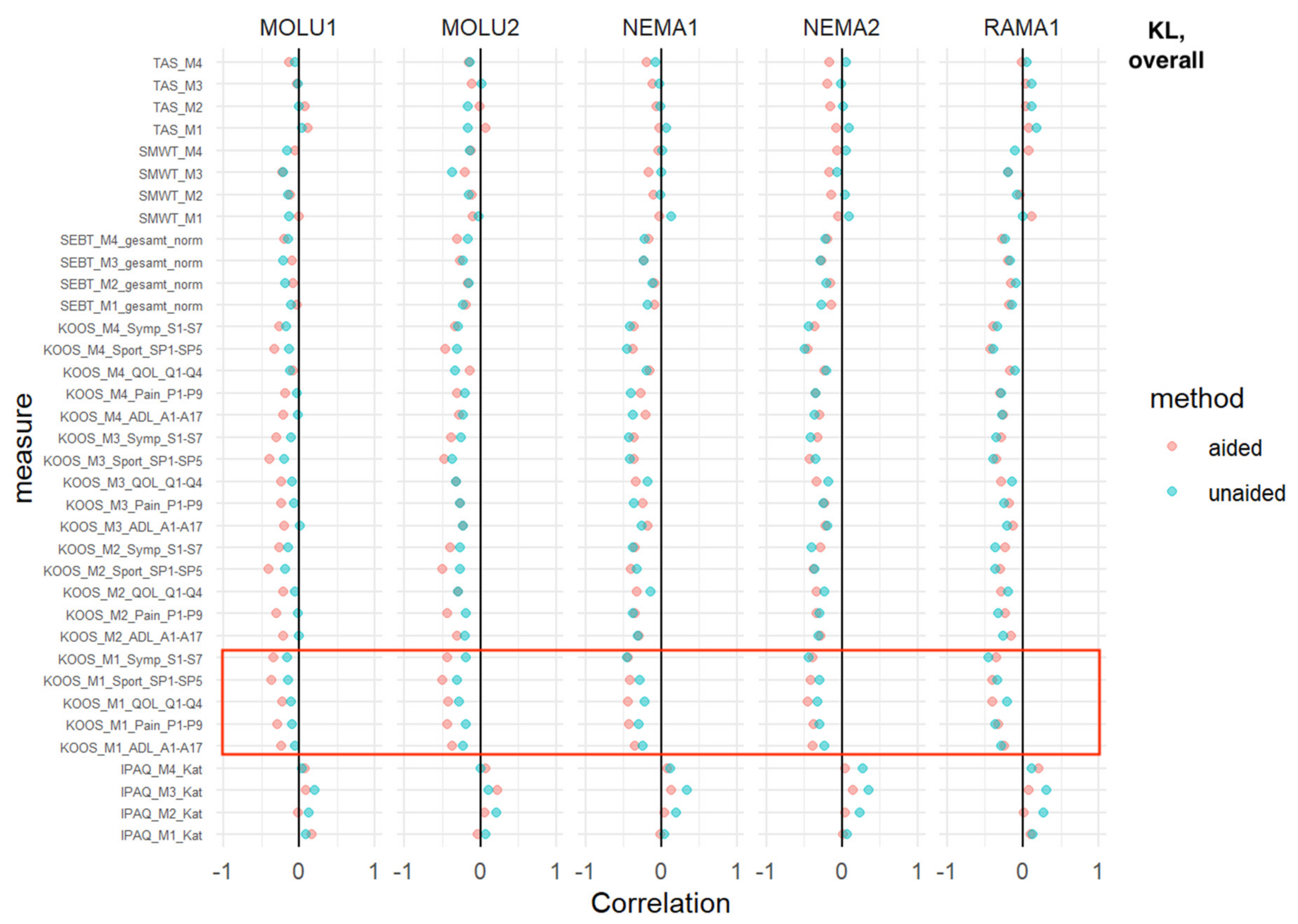
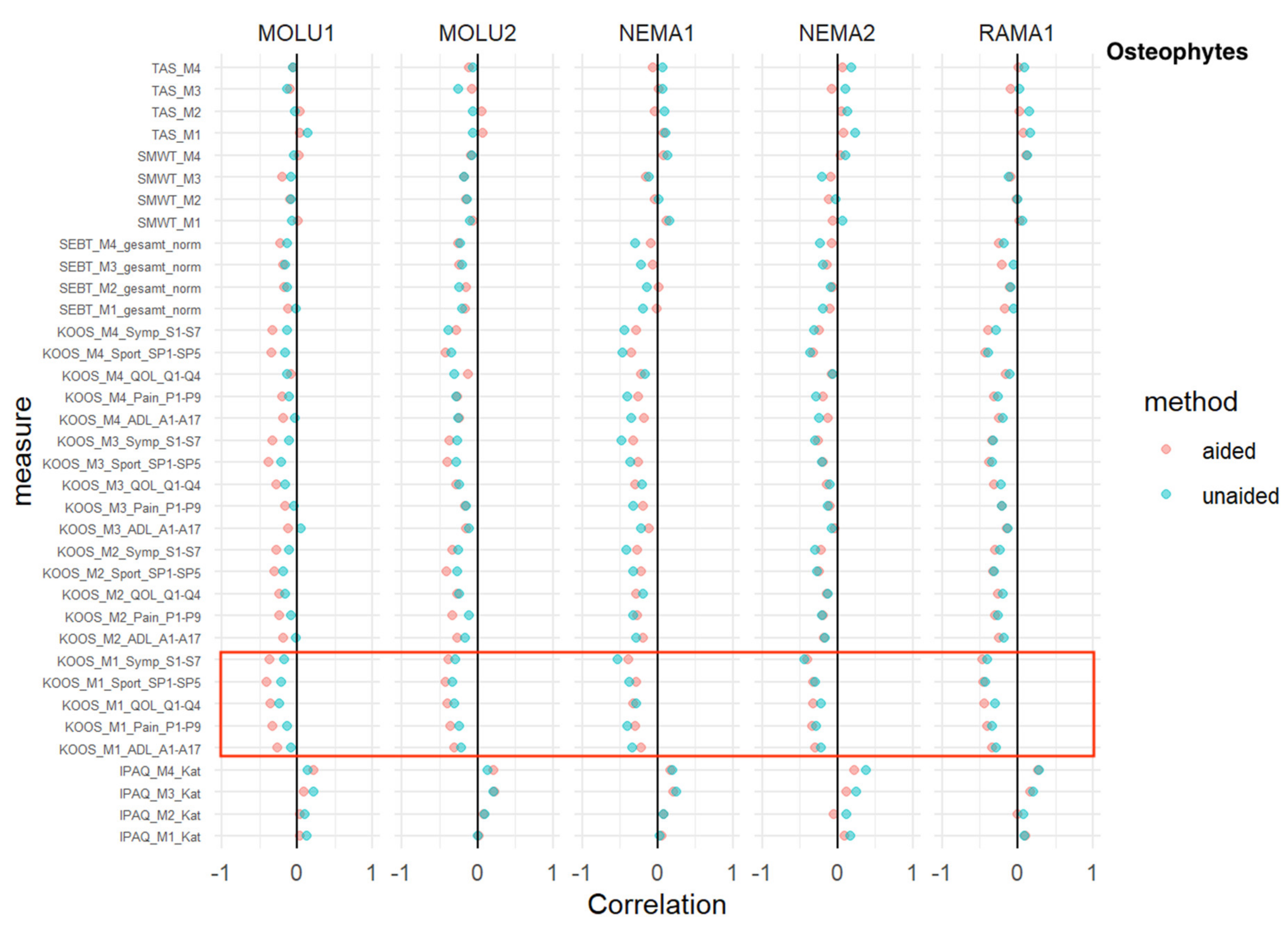
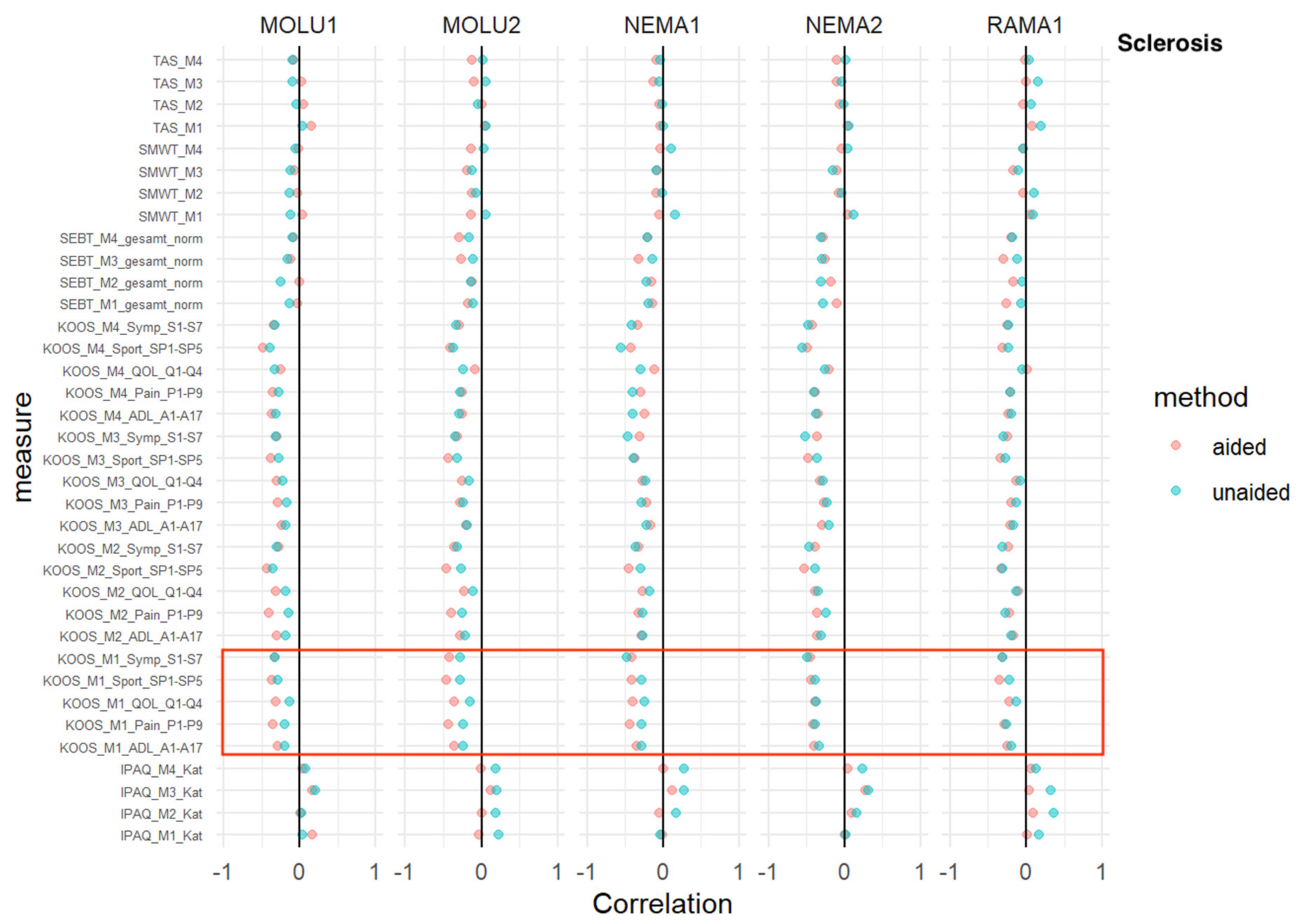
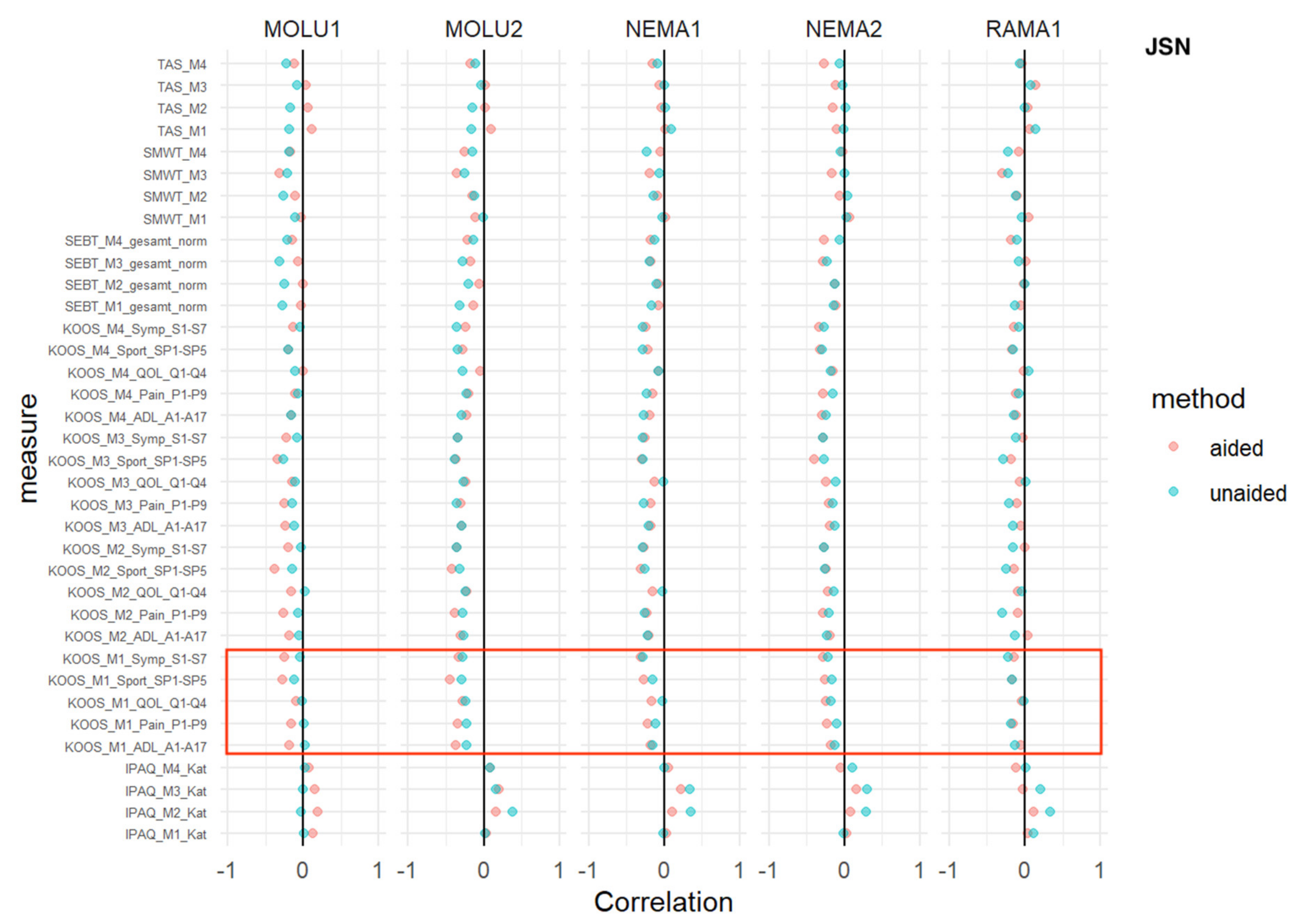
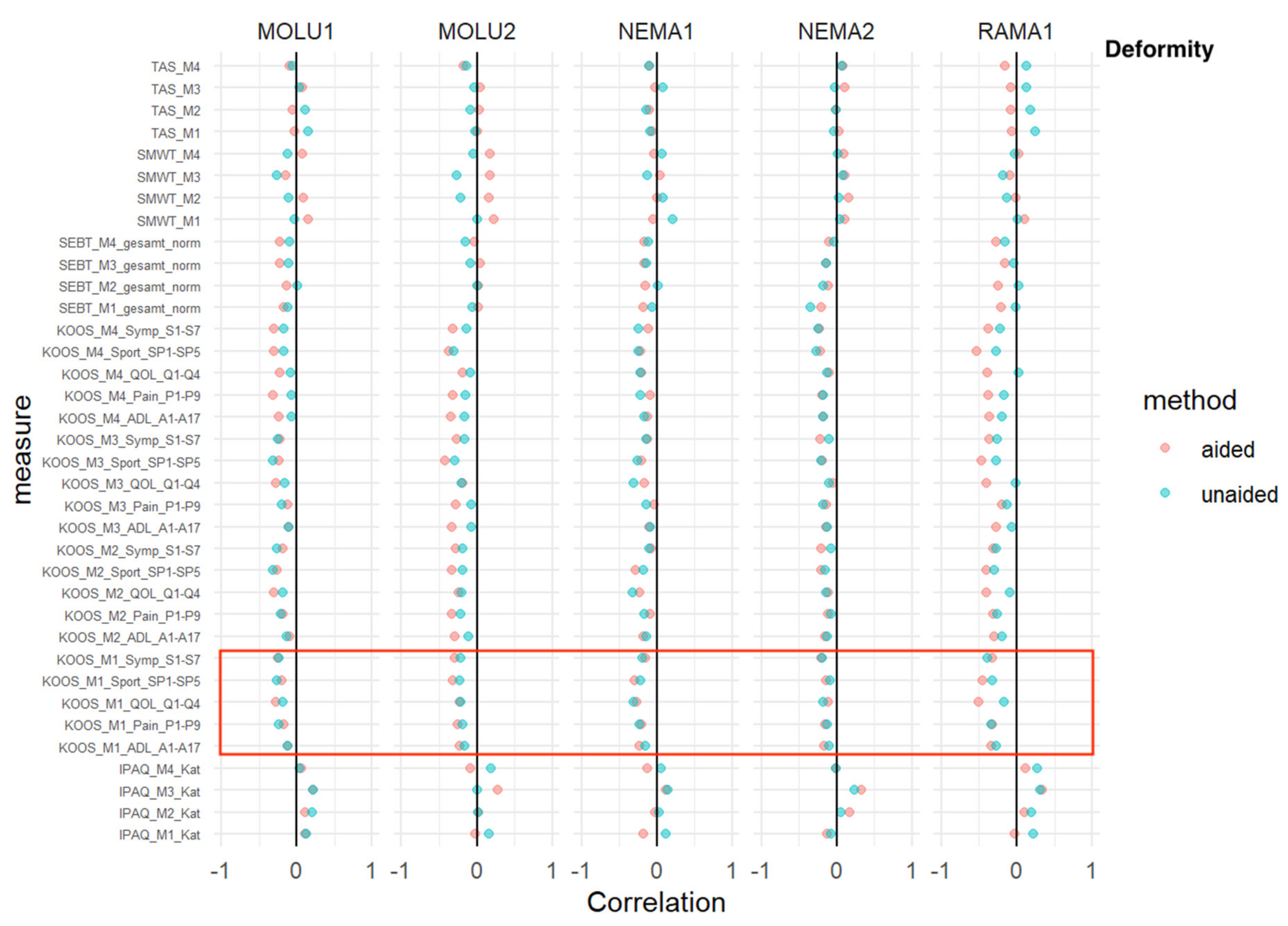
| Part A: Active Trial | Part B: Physician Reader Study | Correlation Analysis | |||||||||
|---|---|---|---|---|---|---|---|---|---|---|---|
| Inclusion | M1 | M2 | M3 | M4 | ff M4 | +3w | +3w | +3w | |||
| X-ray | X | ||||||||||
| Clinical Score | X | X | X | X | ff | ||||||
| AI-Unaided | X→X | ||||||||||
| AI Analysis | X | ||||||||||
| AI-Aided | X→X | ||||||||||
| Start | 01/2019 | 11/2021 | 06/2022 | ||||||||
| End | 10/2021 | 06/2022 | 09/2022 | ||||||||
Timeline | |||||||||||
| Inclusion Criteria | Exclusion Criteria |
|---|---|
| Kellgren–Lawrence score 1–3 | Activated knee OA |
| BMI < 33 | Lower extremity surgery in the past 6 months |
| Free range of motion in the knee joint | Intake or injection of corticosteroids in the past 3 months |
| Long-term NSAR medication | |
| Neurological disease Drug or alcohol abuse Post-traumatic OA |
| Parameter | Assessment | Point Value | KL Score | KL Description |
|---|---|---|---|---|
| osteophytes | none definite large | 0 1 2 | ||
| JSN | no narrowing/doubtful definite JSN extreme JSN no more space/bone on bone | 0 1 2 3 | ||
| sclerosis | none mild mild + cysts strong + cysts | 0 1 2 3 | ||
| deformity | none mild strong | 0 1 2 | ||
| sum total | 0 | 0 | no OA sign | |
| 1–2 | 1 | slight sclerosis or osteophytes | ||
| 3–4 | 2 | slight JSN + osteophytes | ||
| 5–9 | 3 | definite osteophytes + JSN | ||
| 10 | 4 | end-stage OA |
| KL | Osteophytes | Sclerosis | JSN | Deformity | ||||||
|---|---|---|---|---|---|---|---|---|---|---|
| Unaided | Aided | Unaided | Aided | Unaided | Aided | Unaided | Aided | Unaided | Aided | |
| PA | 89.67% | 95.49% | 72.95% | 87.68% | 83.25% | 96.03% | 87.87% | 93.67% | 85.51% | 93.24% |
| PCA | 67.3% | 67.28% | 66.66% | 66.24% | 65.56% | 57.82% | 64.37% | 61.94% | 55.91% | 34.61% |
| AC2 | 0.68 | 0.86 | 0.19 | 0.64 | 0.51 | 0.91 | 0.66 | 0.83 | 0.67 | 0.9 |
| CI | 0.614:0.754 | 0.816:0.909 | 0.45:0.332 | 0.548:0.72 | 0.394:0.633 | 0.868:0.943 | 0.585:0.734 | 0.793:0.874 | 0.56:0.782 | 0.85:0.943 |
| Mean Correlation | |||||
|---|---|---|---|---|---|
| KL, Overall | Osteophytes | Sclerosis | JSN | Deformity | |
| aided | −0.207 | −0.163 | −0.207 | −0.141 | −0.142 |
| unaided | −0.158 | −0.136 | −0.163 | −0.125 | −0.103 |
Disclaimer/Publisher’s Note: The statements, opinions and data contained in all publications are solely those of the individual author(s) and contributor(s) and not of MDPI and/or the editor(s). MDPI and/or the editor(s) disclaim responsibility for any injury to people or property resulting from any ideas, methods, instructions or products referred to in the content. |
© 2023 by the authors. Licensee MDPI, Basel, Switzerland. This article is an open access article distributed under the terms and conditions of the Creative Commons Attribution (CC BY) license (https://creativecommons.org/licenses/by/4.0/).
Share and Cite
Neubauer, M.; Moser, L.; Neugebauer, J.; Raudner, M.; Wondrasch, B.; Führer, M.; Emprechtinger, R.; Dammerer, D.; Ljuhar, R.; Salzlechner, C.; et al. Artificial-Intelligence-Aided Radiographic Diagnostic of Knee Osteoarthritis Leads to a Higher Association of Clinical Findings with Diagnostic Ratings. J. Clin. Med. 2023, 12, 744. https://doi.org/10.3390/jcm12030744
Neubauer M, Moser L, Neugebauer J, Raudner M, Wondrasch B, Führer M, Emprechtinger R, Dammerer D, Ljuhar R, Salzlechner C, et al. Artificial-Intelligence-Aided Radiographic Diagnostic of Knee Osteoarthritis Leads to a Higher Association of Clinical Findings with Diagnostic Ratings. Journal of Clinical Medicine. 2023; 12(3):744. https://doi.org/10.3390/jcm12030744
Chicago/Turabian StyleNeubauer, Markus, Lukas Moser, Johannes Neugebauer, Marcus Raudner, Barbara Wondrasch, Magdalena Führer, Robert Emprechtinger, Dietmar Dammerer, Richard Ljuhar, Christoph Salzlechner, and et al. 2023. "Artificial-Intelligence-Aided Radiographic Diagnostic of Knee Osteoarthritis Leads to a Higher Association of Clinical Findings with Diagnostic Ratings" Journal of Clinical Medicine 12, no. 3: 744. https://doi.org/10.3390/jcm12030744
APA StyleNeubauer, M., Moser, L., Neugebauer, J., Raudner, M., Wondrasch, B., Führer, M., Emprechtinger, R., Dammerer, D., Ljuhar, R., Salzlechner, C., & Nehrer, S. (2023). Artificial-Intelligence-Aided Radiographic Diagnostic of Knee Osteoarthritis Leads to a Higher Association of Clinical Findings with Diagnostic Ratings. Journal of Clinical Medicine, 12(3), 744. https://doi.org/10.3390/jcm12030744





